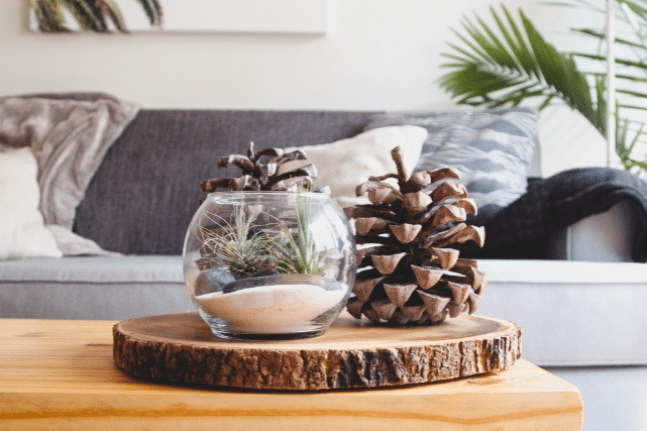How to feng shui your home
Described as the Chinese art of placement, feng shui offers principles, guidelines and tools to help you create harmony and balance in your environment. You can think of feng shui as architecture, design or decorating with an energetic spin. Considering feng shui before renovating can help guide you regarding layout and design. You may discover a more harmonious placement for features such as windows, doors and stairs, or reconsider room layout.
Feng shui Master Gayle Shakti Atherton says, “The Chinese consider that building with feng shui is the ultimate use of feng shui. Building with feng shui brings astronomical returns in all areas of life: love, romance, relationships, money and health, plus you’re creating a healing environment.”
Before you begin
Feng shui means “wind water” and focuses on the flow of energy, known as chi, towards, through and within your Home. As you apply feng shui principles, you’re drawn into a holistic consideration of how your home interacts with and is affected by its environment. Ideally, feng shui concepts are considered before a move, building or renovation takes place, and it begins with critical assessment of the property itself.
The ideal location for your home is one that creates the “Belly of the Dragon” or “armchair” configuration. Terah Kathryn Collins, author of The Western Guide to Feng shui, describes it. “A classically harmonious configuration of land was much like the shape of an armchair and often called the Belly of the Dragon. The preferred plot for building sat on even ground and was embraced and protected in the back and around the sides by mountains, hills or a forest, similar to the back and sides of an armchair. The land then descended to a lower level in front of the plot, where a river, stream, pond or lake completed the ideal location.”
An “armchair” location reflects ancient Chinese principles. If you’re looking for land or a house, or you’re undertaking a total renovation/rebuild, keep this configuration in mind. If, like most of us, you’re in a position where you are working with what you’ve got, you can re-create aspects of the “armchair” ideal through landscaping, tree planting and the creation of stone or wood fences or outdoor walls, gazebos, trellises and so on. The aim is to establish protective barriers down both sides and at the rear of your property. These enhance stability and create containment for prosperity.
Declutter
Whether you’re renovating, moving or looking to build, decluttering is key. If you think you’re ready to change your space but haven’t yet cleaned out the garage, storage cupboards/wardrobes or garden shed, think again. You must release stagnant areas first. This ensures your chi is flowing smoothly.
When you’ve released physical stuff — and the energy/emotion attached to it — you gain clarity. Making authentic choices is easier and you put yourself in a better position to ensure a smooth renovation, move or build experience.
Yin and yang
Feng shui seeks to balance the two primary extremes of yin and yang. Yin is feminine and represents things that that are back, cool, dark, soft, wet, earth, moon and so on. Yang represents what is front, light, hot, hard, dry, sky and sun. A balance between the two is needed to create comfort.
Different sections within the home are allocated a natural yin or yang resonance. The front entrance and rooms close to the front of the house are considered yang, as energy is more active and stimulated here. Locating your living room, kids’ play area, kitchen or home office nearer the front door pairs the active function of the room with its location in the home. The rear of the house is associated with yin energy and is ideal for bedrooms, meditation space and other rooms with quiet, reflective yin-like purposes.
Rivers and roads
Feng shui considers streets to be rivers. The ideal river (road) on which to live is one that moves not too quickly nor too slowly, but just right. Gerry Heaton, author of Feng shui for Australians, comments, “The street you live on will have a very big effect on your home.” Living on a busy road creates a unique set of concerns. First, chi rushes past so quickly it’s unlikely to properly energise your house. Chi must then be drawn towards your home. This can be done with an energy-attracting front yard feature, such as unique landscaping or an eye-catching letterbox or fencing.
Being exposed to constant traffic noise and energy stimulation has a depleting effect. Calming and protective cures are needed to reduce the impact of noise and the constantly active road energy. Gerry Heaton suggests, “In my experience this is best achieved by employing a combination of screening plants, walls and fountains in the front garden.”
Living on a cul-de-sac means chi needs to be energised, as the dead-end street acts like a pond in which energy pools and stagnates. Wind chimes, windmills, mobiles, bird feeders or even a flagpole may be ways to go about this.
If your house is situated such that the street is above it, or your driveway has a steep downward slope, you’ll be negatively affected by chi rushing too quickly down towards you. Other sticky house locations include those at the end of a T-intersection or crossroads, or living on a corner of a roundabout.
In these situations, intense chi spikes (as in a roundabout situation) or rushes (as in a T-intersection or downward-sloping driveway) too quickly towards your home. Physical barriers such as fencing (as solid as possible, ideally brick or stone over wood) or thick and tall tree fences or high hedges are needed to deflect and provide protection from rushing chi.
Using landscaping for protective feng shui means your cures easily blend into your streetscape. Other classic feng shui cures, such as fountains, statues, water features and wind chimes, can also be employed. These need to be located on your property, somewhere between your front door and the offending road influences. Objects such as fountains and statues act as barriers to slow and resist chi flow, making it more manageable. Wind chimes or crystals break up chi so that some is scattered and just enough enters your space.
Indian feng shui
Vastu shastra, Indian feng shui, focuses on the varying influences of the sun. Here the morning and early midday sun is considered most positive, while the afternoon and evening sun is depletive. According to vastu, it’s preferable to maximise window and open spaces on the sides of the house that receive the morning and early noon sun, while minimising windows and creating solid walls and features (such as storage cupboards or wardrobes) on the sides of your house that receive the afternoon and setting sun. This supports your home in receiving and holding the positive morning sun influences while minimising the depleting influences of the afternoon and evening sun.
These principles can also be applied via landscaping. Consider lower hedges or fences on the early morning/noon sun side of your garden and incorporate tall hedges, mature trees or high fences on the side of your property that receives the afternoon and setting sun.
Reflective surfaces such as ponds, water features, pools and mirrors are also more beneficial on the sides of your home that receive the morning and noon sun, as these then amplify positive energy.
Shapes
Since balance is key, symmetrical complete shapes are preferable to asymmetrical or off-centre designs. If your house is L-shaped or has cut-outs (where sections of what would be an otherwise straight wall are missing), balancing efforts are needed to energise these missing areas.
If you’re building from scratch, ensure your roof is square or rectangular. The house underneath might be L-shaped with an outdoor patio area, but if everything is under one roof, balanced chi is maintained.
If you have missing sections, you’ll need to apply cures to create harmony. In the case of an L- or other odd-shaped house, place a statue, mature tree or other solid object in the missing corner. You want to create energy lines so that your cure would turn the current house shape into a balanced symmetrical design if lines were drawn from it to the corners of the house.
Front entrance
Your front entrance, as the “mouth of chi”, is most important. With limited time or funds, this would be the one area to renovate and re-energise. The way your home welcomes or resists the street shows how easily or not chi finds its way across your threshold. Your front door must be easily accessible and ideally visible from the street. Heaton says, “As chi comes to us in curves it is better to have the path to your front door curve rather than be absolutely straight.”
Altering your front walkway to a meandering or curved rather than straight path is ideal. Other alternatives to break up the rushing energy on a straight path include strategically placing plants and pots to create a wavy shape from street to front entrance. Or you could place a fountain in the middle of the walkway or statues to one side to curve the energy. A wind chime or mirror at the front door also helps diffuse charging chi from a too-straight path.
Stairs
Stairs act as powerful waterfalls of chi, drawing chi down them. Locating stairs so they point away from front entrances and bedrooms is preferable. Stairs that face the front door channel chi down and out of the house. The top of a set of stairs pulls chi from rooms they face, while rooms that the bottom of a set of stairs flow into can be flooded with the raging chi pouring down from the upper level.
Treatments for stairs are designed to bring about balance and peaceful waters. Terah Kathryn Collins suggests stopping the chi rolling out a front door “by installing some kind of aesthetic barrier between door and stairs, such as a screen, plants, furniture or art”.
When space limitations may prevent this, other cures such as hanging a mirror facing the stairs or a round faceted crystal above the bottom step are options. If you have pictures on the wall your stair runs up or down, hang them in a straight horizontal line rather than with the slope of the stairs. The horizontal line helps lift the chi, whereas hanging pictures on the slope line of the stairs “accentuates the waterfall shape”.
Master bedroom
As a place of both rest and intimacy, the master bedroom requires special consideration. Bed placement is important and has a particular influence on relationships. Place the bed so you can see the bedroom door comfortably from the bed. Small, discreet mirrors can be used to facilitate this if the room layout makes it tricky. In addition, bedheads should ideally be on solid walls and not under windows. Feet should not face the door of the room via a straight line. Mirrors (especially those that might be on sliding doors of a built-in) should not directly face the bed.
Consider the layout of the master bedroom: where will wardrobes, windows and doors (the entry door as well as any ensuite doors) go? Can you ensure these are located such that the bed can be placed in a strong and safe position as described? Considering vastu theories regarding the influences of the sun, can you situate windows on walls that receive morning sun, while locating built-ins or bookshelves on walls that receive afternoon or evening sun?
Kitchen
As it’s the place where you and your family members are fed and receive nourishment, keeping the kitchen clean and organised is key. Good ventilation is also important, so ensure vents and exhaust fans are in good working order. Ideally, the kitchen bin should be kept hidden (perhaps in a cupboard), emptied regularly and kept clean.
Derelle Ball, of Feng Shui 1689, highlights the importance of appliance placement in the kitchen, saying, “The placement of the stovetop and oven are an important feng shui consideration. Ideally, you should avoid having the stove/oven directly opposite a door to avoid a pathway of sha chi negatively affecting the location where food is cooked for the family. It is also better to place the oven in a location where it has a solid backing from a wall, rather than in a centre island location where it is not supported by stable chi.”
Renovating with feng shui can mean an investment of time, energy and money to enhance your living space. However, doing so can align you more positively with universal energy. Any feng shui approach to renovating, building or moving must first begin with a thorough declutter or repurposing spree. Once the old is removed or passed on, you’re truly ready to realign your space and welcome the new.








